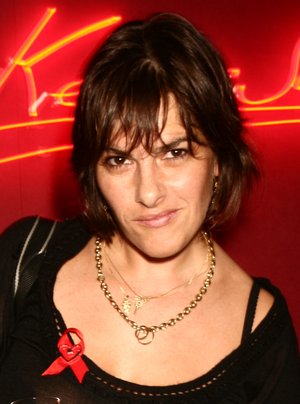Tracey Emin was born into a Turkish Cypriot family, and has obtained degrees from the Maidstone College of Art and the Royal Academy of Art. The versatile artist expresses her art through extremely diverse media and forms: drawing, video, sculpture, embroidery, books, painting, neon signs, photographs. She puts herself on display, using events from her life, and crudely expresses her humiliations, wounds, and successes. Her works evoke love stories experienced with a mix of heartbreak, disappointment, and pleasure. If a feminism is revealed in her work, it is solely by way of an autobiographical and intimate reality. Her first solo exhibition took place in 1993 in the White Cube gallery in London. At the time, the gallery consisted only of a single white room, four meters to each side, an experimental space run by Jay Jopling, intended to be the smallest possible exhibition space where young artists could express themselves; however, the gallery’s would also never show the same artist twice. Her exhibition, bearing the ironic title My Major Retrospective, consisted of heap of all kinds of pieces and images created between 1983 and 1993. She then launched the Tracey Emin Museum project. Since she didn’t have a workshop, she rented a store on Waterloo Road and issued Emin Bonds, which she sold for 50 or 500 pounds sterling, in the form of wood cut engravings, for which she guaranteed a doubling in value over a year or a refund. Their success allowed her to rent the space and buy equipment. During the 1990s, she joined the ranks of the Young British Artists (like Sarah Lucas*, the Chapman brothers, or Marc Quinn), a movement initiated by gallery owner and collector Charles Saatchi and artist Damien Hirst. As such, in 1997 she participated in the Sensation exhibition at the Royal Academy of Art, which enjoyed great success while also being shrouded with scandal. In 1999, she found herself among the four artists selected and exhibited for the very prestigious Turner Prize – which rewards a British artist under the age of 50. She caused a scene by showing My Bed: her own unmade bed, left as is following her breakup with her lover, covered with used condoms, bloody underwear, and the carcasses of empty bottles. Her works obsessively dwell on the rape she experienced during adolescence, her miscarriages, her relationship with sex. Thus, one of her most famous pieces, Everyone I Ever Slept With, 1963-1995, consists of a small tent the inside of which is put together using appliqué techniques (attachment of small pieces of fabric to a larger piece) and covered with the names of all the people she slept with. In 1996, she locked herself up in a room fitted into a gallery, equipped with nothing but painting materials, in the hopes of exorcising her pictorial demons. Lenses inserted into the walls allowed spectators to watch her paint in the nude. While she began painting using style and imagery reminiscent of the work of Egon Schiele, Edvard Munch, or Yves Klein, she ended up finding her own distinct style through the outpouring of autobiographical images. The piece was preserved integrally. With respect to the provocative relationship she maintains with the public, forcing them to act as voyeurs, she explains in an interview published in 2007 by ArtPress magazine: “We are the focus of our dreams and … we create everything inside the dream, including the other protagonists. In the dream, I’m the one talking, but I’m also the other people involved, and I see myself through them.” That same year, she surprised the public by the relative restraint she demonstrated with her presence in the British pavilion at the 52nd Venice Biennale. She chose to hang sentences written in the form of neon signs, graphically recalling handwriting and expressing the power of “spoken sentences.” She also showed a series of watercolours created following her abortion. The year after being voted a lifetime member of the Royal Academy of Art in 2007, she was featured in a solo exhibition at the Scottish National Gallery of Modern Art.
Anne MALHERBE
